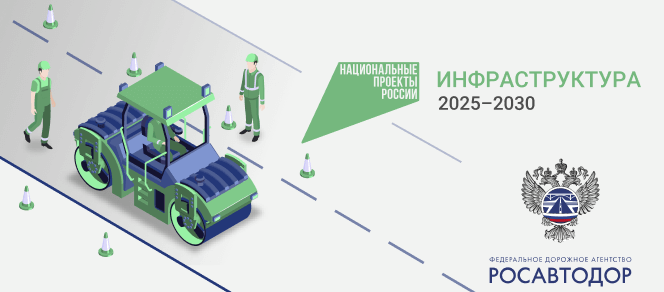Road dictionary
Basic concepts and terms
ROAD CLOTHING is a multi-layered structure within the carriageway of a highway that perceives the load from a motor vehicle and transmits it to the ground.
THE RIGHT-OF-WAY is a strip of terrain allocated for the location of a road on it, the construction of auxiliary structures and the planting of roadside green spaces.
TRAFFIC INTENSITY is the number of cars passing through a certain section of the road per unit of time (per day or per hour).
CAPACITY is the maximum possible number of vehicles that can pass along the road per unit of time.
REPAIR OF AUTOMOBILE ROADS is a complex of works on reproduction of its original transport and operational characteristics, in which are executed compensation of the wear of the coating, restoration and improvement of its evenness and coupling qualities, elimination of deformations and damage to the pavement, the roadbed, elements of the arrangement of the road.
MAJOR REPAIR is a complex of works in which a complete restoration and improvement of the performance of road clothing and pavement, roadbed and road structures is carried out, worn-out structures and parts are replaced with more durable ones. If necessary, the geometric parameters of the road are increased, taking into account the increase in traffic intensity and axial loads on the car axles within the norms.
RECONSTRUCTION OF AUTOMOBILE ROADS is a complex of construction works on an existing road in order to increase its transport and operational indicators with the transfer of the road as a whole or individual sections to a higher category. Includes: straightening of individual sections, softening of longitudinal slopes, arrangement of bypasses of settlements, widening of the roadbed and carriageway, strengthening of the construction of roadways, widening or replacement of bridges and engineering structures, reconstruction of intersections and junctions, etc. The technology of work is similar to the technology of road construction.
ARTIFICIAL STRUCTURES are structures arranged on roads at the intersection of rivers, ravines, mountain ranges, roads and other obstacles, snow-proof, anti-avalanche. The main artificial structures: bridges, overpasses, tunnels, trestles, pipes, drainage devices, etc.
A TRAFFIC ISLAND is an element of the road arrangement separating lanes of traffic in opposite directions (including lanes for cyclists), structurally highlighted with a curb stone over the carriageway or marked with technical means of traffic management and designed to stop pedestrians when crossing the carriageway.
DRAINAGE DEVICES are a complex of structures that divert water from the roadbed and pavement and prevent their waterlogging (side ditches, trays, drainage wells, water-absorbing and drainage devices).
INTELLIGENT TRANSPORT SYSTEMS (ITS) is a complex of systems that helps to operate the transport network more efficiently using information, communication and management technologies embedded in the road infrastructure or in a vehicle. The ITS complex is capable of performing the functions of dispatching situational and operational coordination of interactions of all road users, special services and departments.
THE AUTOMATIC WEIGHT AND SIZE CONTROL POINT (AWSCP) is a system that allows to monitor traffic around the clock and identify overloaded cars. The complexes are able to automatically weigh and determine the dimensions of the vehicle without the need to brake it or stop completely.
A LIFE CYCLE CONTRACT is a contract for the implementation of road activities, which provides not only for road works, but also for the subsequent maintenance of the object by the contractor for several years.
THE TECHNOLOGIES OF REPAIR WORK are determined taking into account the type of repair carried out.
THE TECHNOLOGY OF REGENERATION AND STABILIZATION (COLD RECYCLING) increases the endurance of road clothes due to the use of connected layers of the base, strengthens the bearing capacity of the road, allows to optimize the cost of work by reusing the materials of existing road clothes.
THE TECHNOLOGY OF VOLUMETRIC DESIGN OF ASPHALT CONCRETE MIX allows to choose the optimal composition of the mixture taking into account specific climatic conditions, transport load, predict the durability of asphalt concrete in road construction and increase the service life by 20–30%.
MANUFACTURE OF CRUSHED STONE-MASTIC ASPHALT CONCRETE is used to obtain high performance characteristics of the top layer of the coating — the most important structural element of the road, which should be safe, easy to maintain and durable. For the preparation of the mixture, durable cuboid crushed stone, high-quality bitumen in larger quantities, mineral powder and a stabilizing cellulose additive are used.
ROAD FENCES are an element of road infrastructure that increases traffic safety. Forced exits of vehicles from bridges and overpasses, as well as collisions with oncoming vehicles are prevented by barrier structures and parapets. The exit of animals to the roadway and the movement of pedestrians are controlled by railing-type structures. Axial barrier fencing is installed to separate traffic flows on 4- and 6-lane roads of category I. If the width of the dividing strip is more than three meters, a metal double-sided bump is used, and if the width is three meters or less, reinforced concrete fences of the parapet type with a special profile of the side surfaces.

Национальный проект «Инфраструктура для жизни» в части дорожной деятельности



.png?v=YRr4v9MjmZag6mtdT4aibqJTnL-AHWRxt-OjuLF7b88)
.png?v=dDiT9HbNjG4bHbfyO2VXeFYl7WkCkU6mzgQsbc9ZACE)


